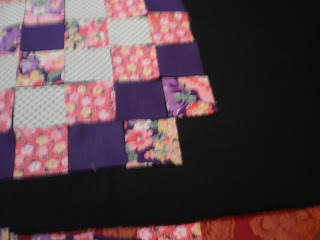Saturday, July 21, 2018
Traditional Block Taken Further
Following on from our last post whe we looked at the Around The World quilt block here is the block expanded into a quilt. A great winters day project. Just keep following your rounds of squares as commenced in the sampler block. Quiet quickly your block will grow in a quilt.
Thursday, July 19, 2018
Tuesday, July 17, 2018
Sampler Quilt: Block 2: Around The World
“Around The World”
This block is constructed of squares 2 1/4inches in size. It is the placement of the different rounds of colour that leads to the name “Around The World”
Step 1: Cut 4 strips, lengthwise across the fabric, 2 1/4inches wide. 4different colours are utilized for this block.
Step2: Cut each strip into 2 1/4inch squares.
Step 3: Lay down your centre block and 4 blocks around it, as per picture.
Step 4: Continue to lay squares of fabric around the middle square as per the following pictures.
Step5:
Step 6: After the 3rd round the corners need to be filled in...as per the following pictures.
Step 7: Your block laid out will resemble to some degree the following picture.
Step 8: Each row will need to be sewn together, sew each block of the row together with a straight stitch and a 1/4inch seam
:Step 9: Once all blocks have been sewn into rows the rows need to be sewn together utilizing a 1/4inch seam.
Wednesday, July 11, 2018
Free Pattern: Railway Fence
In this post l thought l would share with you a quilt l designed utilizing the railway Fence block.
There are 6 pages from showing the quilt to the pattern pieces required. Do play around with the blocks and see if you can create other designs.
www.koalaquiltnsew.com.au
There are 6 pages from showing the quilt to the pattern pieces required. Do play around with the blocks and see if you can create other designs.
www.koalaquiltnsew.com.au
Tuesday, July 10, 2018
Quilt Block Railway Fence Variations.
These three quilts show how you can sew 3 strips of fabric sewn together, cut into 6 1/2 inch blocks can create a variety of different patchwork designs. The 2 peach colored quilts were made from furnishing fabrics bought at a garage sale and the pink quilt the fabric is a polyester fabric.
Do make up a number of the Railway Fence Blocks then have a play around with different that can be created.
Do make up a number of the Railway Fence Blocks then have a play around with different that can be created.
Tuesday, July 3, 2018
Sampler Quilt: Block 1; Railway Fence
Sampler Quilt
Block 1: Rail Fence.
Block 1: Rail Fence.
This is a great block to start the sampler with and your patchwork journey if you are a beginner. The skills you will learn thru this block are the cutting of fabric with a rotary cutter and ruler, sewing ¼ inch seams, matching up a seam and sewing 3 rows of fabric together.
To support the instructions l have included photos. But do remember any question you may want to ask please go to the Koala Quilt N Sew yahoo group. There you will meet other Block Of The Month participants and l will be visiting regularly http://groups.yahoo.com/group/koalaquiltnsew/
Step 1. By now many of you will have gathered your fabric, here are photos of my fabric choices. The floral fabric in the first photo is my main fabric with the next photo showing the support fabrics and the final photo is of my plain background fabric.
Cut another two strips of the same measurement, one each from the other two fabrics.
If you are left handed cut the opposite way around.
Step 3. This step involves sewing the 3 strips of fabric together. As in many patchwork designs the seams for this block are ¼ inch, straight stitch and with cotton thread. When sewing strips together sew down one way and then back up the other way. If all strips are sewn together in the same direction an arch will form thus creating an impossible piece to use. The piece needs to be ironed at this stage, as in many patchwork pieces iron the seams together and in one direction. If you have a strip of light coloured fabric always iron the seams towards the darker coloured fabric.
Step 4. Place the ironed strip on your cutting board and with your ruler trim off one end. Then measure in 6 1/2 inches with your Perspex ruler and cut with the rotary cutter. We need 4 of these blocks.
Step 5. Sew the two sets of the blocks together, as per photo, using a ¼ inch seam.
Step 6. Sew the two sets of blocks together. In this step the centre seams need to be matched with seams on top blocks going in one direction and the centre seam on the bottom blocks going in the other direction. Thus avoiding bulk forming and being noticeable in the finished project.
Subscribe to:
Comments (Atom)







































